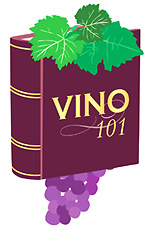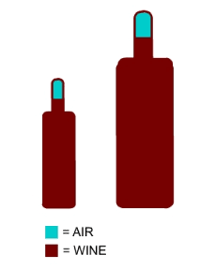 A Server's Perspective
A Server's PerspectiveThe Bigger the Better
By Jorge Eduardo Castillo
When most diners peruse a restaurant's wine list, they will glaze over the large-format bottles because of the hefty price tag. It's as if the thought of spending a lot on one wine choice is too much to handle.
Plus, we as wine drinkers are comfortable with our trusty 750ml bottles. We know what to expect. We know we'll be getting 4 to 5 glasses from each bottle, and that never lets us down. However, as I will explain, it is often more practical, economical, and beneficial to your enjoyment to consider large-format bottles as an option.
First, let's explore all of the different large-format bottles that wine-producers use, along with their quirky names:
| Name | Size | Equivalent in regular bottles | Magnum | 1.5 liters | 2 |
| Jéroboam | 3.0 liters | 4 |
| Rehoboam | 4.5 liters | 6 |
| Methusaleh | 6.0 liters | 8 |
| Salamanzar | 9.0 liters | 12 |
| Balthazar | 12.0 liters | 16 |
| Nebuchadnezzar | 15.0 liters | 20 |
History buffs will tell you that these were all names of important figures mentioned in the Bible (except Magnum, of course). Also, it should be noted that in Bordeaux, France, the rules change and the names of some bottles are different. For example, a Jéroboam is called a Double magnum, a Rehoboam is called a Jéroboam, and a Methusaleh is an Impériale. For our purposes, however, the above measurements and names are accurate for most all American wine lists.
Why go bigger?
Other than the novelty appearance of large formats, the large bottles actually do serve a purpose. Apply here what you already know about oxidation: The more air that gets to the wine, the faster it will age over time. What you might not know is that the ratio of air to wine in a large-format bottle is much smaller. Look at this diagram and you'll see what I mean:

As you can see, in the large-format bottle there is much more wine compared to the amount of air in the bottle. What does this mean? The wine ages more slowly in the large-format bottle because less air gets to the wine, which slows down the oxidation process. This means that a 15-year-old Merlot in a standard 750ml bottle might be over-oxidized and past its peak, while a large-format bottle of the same wine might be just hitting its peak. It also means that while the smaller bottle might remain at its optimum drinking peak for one or two years, the large bottle may enjoy least as long a plateau. (Remember, this same principle holds in reverse for half-bottles, which generally aren't for aging.)
Economics 101
Now let's look at why it might be more economical to order a large-format bottle rather than the 750ml. It is not uncommon to see an entry like this on a restaurant's wine list:
1995 Soandso Cellars Syrah (750ml) $50
1995 Soandso Cellars Syrah (Jéroboam 3.0L) $175
Most people will glaze over the $175 bottle because they already have a $50 bottle in mind. However, say your party has eight people. You know one bottle will not be enough for the table - that would be only about a half-glass of wine per person. You are going to need at least three bottles and probably four in order to ensure everyone gets a fair share.
In this example, four bottles of the 750ml will come to $200, while the Jéroboam, holding the same amount of wine as the four regular bottles, will cost $175. You've just saved yourself $25 by going with the large-format. Not to mention, someone has a nice souvenir to take home.
The Server's Perspective
It is not only patrons who frequently overlook large-format bottles. Often, a server will be taking care of a large party and not once throw out the idea of ordering a large-format bottle. Recommending the large-format is an excellent sales strategy because you are locking them into spending a certain amount of money on wine, but at the same time you are potentially saving them money. This is a win-win. In addition, you are saving yourself a few minutes for each small bottle you would have had to open, and as we know, every minute counts during a rush, especially when you're dealing with large parties.
I remember several years ago when I worked as a server at a high-end restaurant, I convinced the host of a party to purchase a 5-year vertical of magnums from a premium Bordeaux producer ... not an inexpensive purchase by any means. The guests in his party had an amazing time and left feeling that they were treated like kings, so they tipped me accordingly. Not only that, there was about a glass of wine left in each bottle that the host graciously offered to the waitstaff. Luckily, management was generous enough to let us try the wine, so we hung around for a few minutes after work and got to taste some amazing wine that we otherwise may never had an opportunity to try.
In conclusion, remember these key points about large-format bottles:
- Just remember the large-format bottles! Know what your operation has in stock and how to use the varietals/styles with your menu.
- Know the math! Be able to speak quickly and accurately to the host of a party about consumption, price and bottle size.
- Understand perception! Whether true or not, many of us carry the perception that bigger is better. Your guests may feel the same way. Use this your advantage.
- Let the wine sell itself! Accurately describe the large-format wine(s) you offer and how it will function with their menu and you may find your customers jump on the opportunity to enjoy the wine, regardless of the bottle size.
August 2007
Visit www.vino101.com for more details.
Back to the Vino 101 index page




